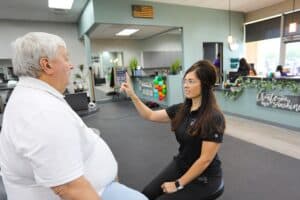by Jamie Miller PT, DPT, CKTP | Litchfield Park Location
When the world starts “spinning,” people suffering from vertigo should know where to go and what to do. Physical therapy is a great source to assist individuals in improving their balance and symptoms related to vertigo. The physical therapist’s role in vertigo treatment will be to assess for the origin of symptoms, minimize the dizziness and spinning, and refer to other medical practitioners if indicated.
What Can Cause Vertigo?
Dizziness and vertigo are common medical issues and affect approximately 20%-30% of the general population. Vertigo can occur in people of all ages. The prevalence of vertigo rises with age and is about two to three times higher in women than in men, accounting for about 2-3% of emergency department visits. The leading causes of vertigo are benign paroxysmal positional vertigo (BPPV), Meniere’s Disease, vestibular neuritis or labyrinthitis, concussion, or vestibular migraine. Excessive drinking of alcohol can also cause symptoms of vertigo. Onset may result from a recent infection, a trauma to the head, or for no known reason.
Vertigo Signs and Symptoms
Vertigo is a type of dizziness in which a person inappropriately experiences the perception of motion (usually a spinning motion) due to dysfunction of the vestibular system (located within the inner ear).

It is often associated with nausea and vomiting and a balance disorder, causing difficulties with standing or walking. A person may feel the sensation that objects in the environment are moving or an intensive sensation of rotation. Symptoms include feelings of spinning, tilting, swaying, unbalanced, abnormal, or jerky eye movements. Other symptoms include headache, ringing in the ears, or loss of hearing lasting a few minutes to a few hours or more.
The onset of symptoms arises in the inner ear. There are tiny calcium deposits that become displaced into one of the inner ear semi-circular canals. Resulting in an imbalance of sensory input to the brain, which measures your balance/equilibrium. This results in imbalance and dizziness, nausea, etc., as the brain receives different stimuli from one ear to the other.

4 Options for Vertigo Treatment
Treatment or therapy for vertigo depends on what is causing it. In many cases, vertigo goes away without any treatment. This is because your brain can adapt to the inner ear changes, at least in part, relying on other mechanisms to maintain balance. For some, treatment is needed and may include:
- Medicine to relieve symptoms of nausea or motion sickness
- Antibiotic treatment or steroids if vertigo is caused by infection
- Surgery
- Vestibular rehabilitation – Canalith repositioning maneuvers. A series of specific head and body movements are used to treat BPPV in which activities are done to move the calcium deposits out of the canal into an inner ear chamber so the body can absorb them. Patients will likely have vertigo symptoms during the procedure as the canaliths move, however, the movements are safe and often effective.
Physical Therapy Exercises for Vertigo Treatment
In physical therapy, patients are treated with canalith repositioning maneuvers, vestibular exercises, balance training, and neck stretching to improve their range of motion. Manual therapy is used to alleviate myofascial restrictions in the neck contributing to pain and headaches, and other modalities. The goal is to help strengthen the vestibular system. The vestibular system’s function is to send signals to the brain about head and body movements relative to gravity. Vestibular rehab may be recommended if you have recurrent bouts of vertigo. It helps train your other senses to compensate for vertigo. This will include retraining of head & neck mobility in horizontal and vertical planes, eye movements including diagonal patterns, and balance and gait activities.
Foothills provides an affordable, individualized, and professionally supervised program designed to build and maintain vestibular system function. Our highly trained staff is here to properly evaluate and quickly identify your vertigo concerns. Our goal is to give you the confidence to get back to doing the things you love.
For a free assessment come to our Litchfield Park location or visit the location nearest you. Begin your full recovery from vertigo symptoms!





